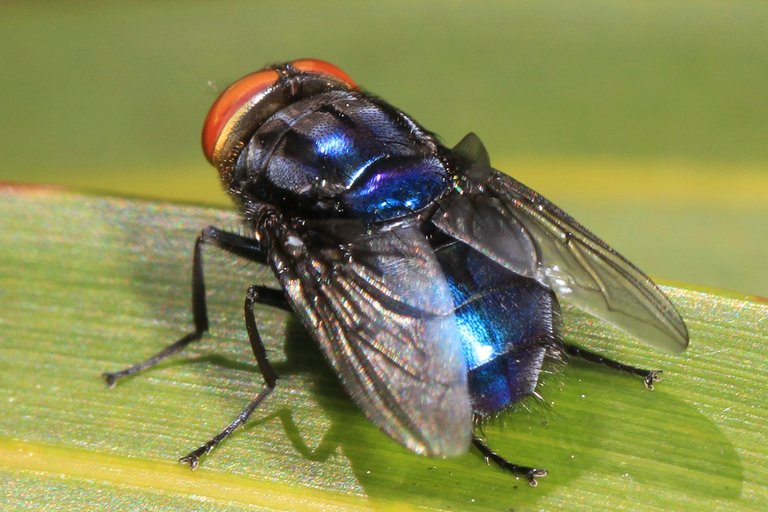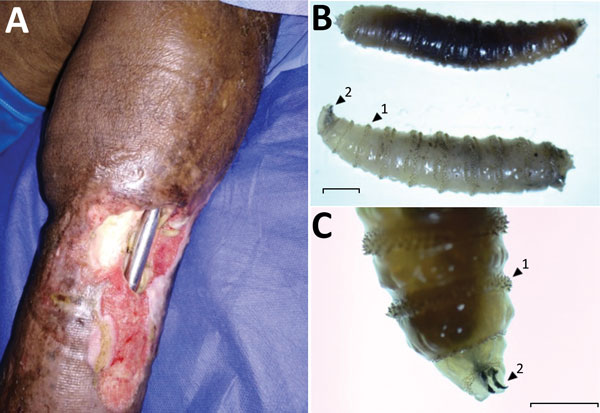I just read about planes being used to release radiation-treated sterile flies on the Nation of Panama. It sounded like a fiction and I was thinking about the amount of money spent on this and why will this be happening. My curiosity got me to keep digging and this was what I got.
I realize that this act has been done for decades by the United States Government to protect livestock and probably human from the tiny flesh eating New World Screwworm larva. For quick clarity, the New World Screwworm isn't a worm as its name may imply rather it is a fly that has a life cycle of 21 days but within this short lifespan, they can travel miles to other parts of the world. Until I saw this story of this fly, I didn't know it existed.
Females Screwworms lay their eggs on the wounds of mammals like livestock animals, deer, and even humans since we are mammals or aren't we? The eggs hatch to become a worm-like larvae and this larvae stay on the wounds but more annoying, it feeds on the tissues of the animals leading to significant damage of the tissues, infection by other microbes, and death.
This isn't a problem that started recently in the 2000s actually, it has a long history. In the 1930s, New World Screwworm was a big problem in the United States and farmers suffered a lot leading to the livestock-industry in Southern US to lose millions of dollars which arose as a result of animal death. When it became a problem, different methods were employed to mitigate the loss and control the infestation. Methods such as shifting livestock breeding to colder times when the larvae activity was minimal so calves would survive and be free from the worm, as well as moving activities that could exposed the animals to wounds such as castration and branding to colder periods of the year but these efforts didn't give good results because the worms were able to survive on the mammals wound and hide there.
In the 1950s, Sterile Insect Technique was developed by the United States Department of Agriculture Researchers and this was because screwworm had become a big problem. The process had to do with sterilizing screwworm flies that were raised in the laboratory via gamma radiation and releasing them into the wild. The process prevents the sterile male screwworms from fertilizing eggs in the females. The flies were released and allowed to compete with the already existing males for mating.
Since the flies have a short lifespan and only mates once, the odds of them mating with a non-sterile fly were reduced and one mating with a sterile partner meant the fly doesn't have any egg to lay which in turn means the generation is completely gone. To test if it was going to be effective, it was done on an island called Curocao, and for the first trial, 400 sterile flies were released per square mile. In 10 weeks, Curocoa was free from the flies as it was completely eradicated. With a successful trial, you guessed it, millions of sterile adult screwworm were released over the Southeastern part of the United States to as to eradicate the flies and they were able to accomplish it in 1966 when the flies were eradicated.
https://s3.animalia.bio/animals/photos/full/original/screwworm-larva-close-up.webp
animalia
While it was eradicated in the Southeastern United States in 1966, Sterilized flies are still released from the atmosphere over 50 years later but this time around in different countries including Mexico in the 1970s, and in Central America. This process is effective but not cost-effective so a plan to create a Transcontinental Screwworm barrier was established in the 1990s in Derien Gap which is a land that borders Colombia and Panama. This border area is shorter compared to the Mexico and the United States Border and so, the flies are dropped there on a regular basis.
For now, there is no permanent solution for Screwworm and airdropping the sterile flies from planes in the Panama borders is still the most effective and cost-effective way to prevent the flies from getting into the Americas again. There are still studies and research on getting techniques that will eradicate the flies as well as will be cost-effective. Scientists are looking to use Crispr to create a mutation in the gene of female screwworm so as to make them sterile and this technique will spread on for generation and so kill the flies population over time. There have been new outbreak of the fly in Africa, and I do not think releasing the flies will be a cost effective method if the fly reaches other continent.
REFERENCE
http://www2.ans.org/pubs/magazines/nn/docs/1999-7-3.pdf
https://www.nal.usda.gov/exhibits/speccoll/exhibits/show/stop-screwworm
https://pmc.ncbi.nlm.nih.gov/articles/PMC7789611/
https://apps.fas.usda.gov/newgainapi/api/Report
https://www.pnas.org/doi/10.1073/pnas.2301525120
https://www.woah.org/fileadmin/Home/eng/Animal_Health_in_the_World
https://www.fao.org/4/u4220t/u4220T0a.htm
https://pmc.ncbi.nlm.nih.gov/articles/PMC5029077/
https://www.fao.org/4/u4220t/u4220t0d.htm
https://publications.aap.org/aapnews/news/30599/Twice-eradicated
https://www.fao.org/4/u4220t/u4220T0j.htm
https://www.cdc.gov/myiasis/hcp/clinical-overview/index.html
https://www.fas.usda.gov/data/costa-rica-costa-rica-declares-screwworm-emergency
https://www.fao.org/newsroom/story/the-screwworm-menace
https://pmc.ncbi.nlm.nih.gov/articles/PMC6077731/
https://www.nal.usda.gov/exhibits/speccoll/exhibits/show/stop-screwworms--selections-fr/1930s
https://www.nal.usda.gov/exhibits/speccoll/exhibits/show/stop-screwworms--selections-fr/introduction


